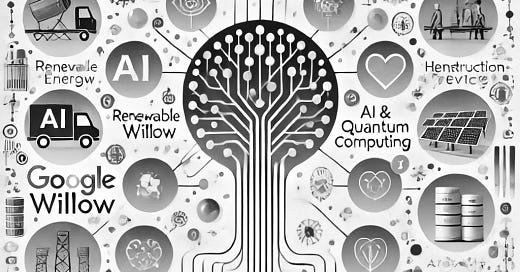🌟 Quantum Leap: What Investors Need to Know About Google Willow's Multi-Billion Dollar Market Potential
Helping retail investors grow wealth from future tech in under 5 minutes per week
In a flash⚡️
Google’s Project Willow represents a bold step into the future of material science and sustainability. But what does it mean for retail investors looking to grow wealth in future tech? This guide explores Willow’s potential impact, applications, and competitive landscape, giving you the tools to evaluate its investment potential.
👉 Curious to dive deeper? Subscribe now and discover how to grow your wealth with the power of future tech!
🚀 What Is Google Willow?
Google Willow is a cutting-edge initiative focused on material innovation and sustainability. By combining AI, quantum computing, and advanced engineering, Willow aims to revolutionize how industries design and utilize materials.
Think lighter, more durable components for cars, or breakthroughs in renewable energy storage. Willow could redefine industries by solving complex material challenges while aligning with sustainability goals.
🏭 Applications Across Industries
Willow’s potential extends far beyond tech, positioning it as a game-changer across multiple industries:
🌱 1. Renewable Energy
Challenge: Efficiency and durability of solar panels and wind turbine components.
Willow’s Impact: Develop materials to boost energy output and reduce costs for renewable infrastructure.
Investor Insight: Growth in renewable energy markets could amplify Willow’s value.
🏗️ 2. Construction and Infrastructure
Challenge: Sustainable, lightweight materials to reduce carbon footprints.
Willow’s Impact: Innovations in cement alternatives and insulation materials.
Investor Insight: Transforming a trillion-dollar industry could attract widespread adoption.
💻 3. Technology and Data Centers
Challenge: Energy consumption and heat dissipation.
Willow’s Impact: New materials to cool servers more efficiently, reducing operational costs.
Investor Insight: Google could directly benefit by improving its own data centers and licensing the tech.
🚗 4. Automotive and Aerospace
Challenge: Weight reduction without compromising strength.
Willow’s Impact: Advanced composites for EV batteries, autonomous vehicles, and space exploration.
Investor Insight: Partnerships with automakers and aerospace companies could drive new revenue streams.
🏥 5. Healthcare and Biotech
Challenge: Precision materials for medical devices and implants.
Willow’s Impact: High-performance biocompatible materials for next-gen healthcare solutions.
Investor Insight: Expanding into healthcare aligns with long-term growth trends in biotech innovation.
💰 Revenue Model and Monetization Potential
Understanding how Willow could generate revenue is critical for retail investors:
Cost-Saving Initiative: Google may leverage Willow internally to enhance its operations, such as improving data center efficiency or Waymo’s vehicle components.
Licensing Opportunities: The project could be monetized by licensing innovations to external industries, creating a direct revenue stream.
Ecosystem Integration: Willow aligns with Google’s broader ecosystem, feeding into products like Google Cloud, Waymo, and Nest devices, offering indirect financial benefits.
🤝 Partnerships and Ecosystem
Collaborations play a pivotal role in Willow’s potential success:
Academic Partnerships: Accelerate research and innovation.
Industry Collaborations: Joint ventures with automakers, renewable energy firms, or healthcare companies could de-risk commercialization.
Investor Insight: Strong partnerships signal validation of technology and market readiness.
📊 Competitive Landscape
Google Willow isn’t alone in the material science race. Let’s compare its competitors:
How Willow Stands Out
Google combines AI, quantum computing, and material science into a unified ecosystem. This multi-disciplinary approach could give Willow an edge in scalability and versatility across industries.
⚖️ Risks and Challenges
Retail investors should be aware of potential hurdles:
R&D Costs: High upfront investment with uncertain timelines for ROI.
Regulatory Challenges: Potential obstacles in industries like healthcare or construction.
Scalability: Adapting innovations across diverse sectors could pose technical and logistical challenges.
🌟 Why It Matters for Investors
Google Willow’s success could have far-reaching implications for retail investors:
High-Growth Potential: Exposure to transformative industries like renewable energy and healthcare.
Diversification: If commercialized, Willow could impact multiple sectors, spreading risk.
Sustainability Alignment: Investors increasingly favor projects that align with ESG principles.
👉 What do you think? Would you consider Google Willow a promising bet for the future? Let’s discuss in the comments!
🕒 Timeline and Milestones
Key events to watch:
Mid-2024: Updates on initial pilot programs in renewable energy or automotive sectors.
2025: Potential partnerships or licensing announcements.
2026–2027: Commercialization milestones, revealing Willow’s revenue-generating potential.
🔍 Final Thoughts: Should Retail Investors Care About Willow?
For retail investors looking to grow wealth in future tech, Google Willow represents a fascinating opportunity. Its applications across industries, coupled with Google’s vast resources, position it as a potential disruptor.
However, high R&D costs and uncertain commercialization timelines mean cautious optimism is key. For those with a long-term investment horizon, monitoring Willow’s progress and its adoption across industries could reveal significant opportunities.





